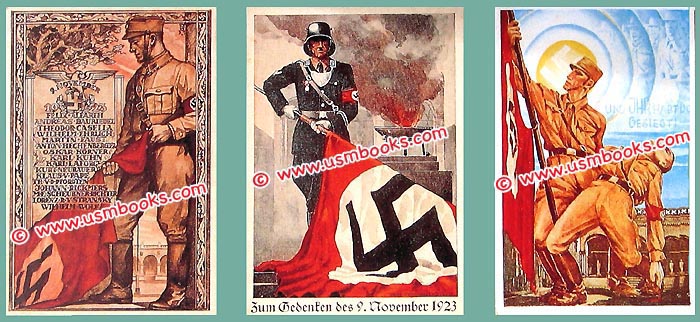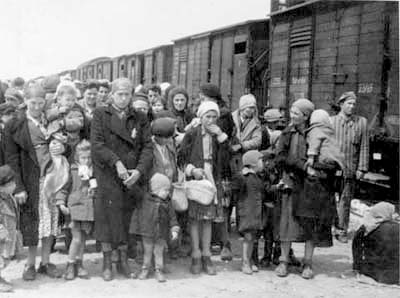Mormons do as they're told -- whether it's Hitler or the local bishop.

I always decline desserts, especially those made with white flour, white sugar and butter. But when a fragile, adorable old lady appeared at my front door, proffering a huge, warm strudel drenched with vanilla icing, cinnamon and walnuts, what could I do?
“We want to welcome you to the neighborhood,” she said, introducing herself as Lotte Krause. “And this is my husband, Helmut,” she added.
“We think you will be a good girl, not like the one, Julia, who was here before,” Mr. Krause said. “She had her black and Jewish friends coming around all the time."
I realize this doesn't sound believable, but I swear he said it.
I had been told that some Nazi Mormons lived nearby, but I never expected them to manifest themselves as a touchingly frail and tender couple, if at all.
They were just too cute to love Hitler! And where did this Julia person find black and Jewish friends in Salt Lake City? I had to go all the way to New York to find some, and they were my favorite people.
It doesn’t surprise me anymore that people have prejudices. What I don’t get is how they can feel comfortable expressing their bigotry, especially to a complete stranger.
In the past few years, I had stopped seeing both a dentist and a chiropractor after they made racist and anti-Semitic remarks, but not before retorting, “My father is Jewish, and I love black people.”
I was so stunned by Krause’s comment that I just thanked them for the strudel and let it pass.
I was upset with myself for having done so. Maybe it was because they were so old, and I wasn’t comfortable being confrontational with them.
It certainly wasn’t because of the strudel! I gave half to my parents and half to my boyfriend’s parents, and I didn’t even lick the knife.
THE GREATEST TABOO
I discussed the incident with a couple of Mormon friends at the Church-owned Deseret News, where I was a copy editor. Both of them insisted that we leave the office before talking about it.
This was the Hamburg ward house of the LDS Church.
The Church’s general rule is that its converts all over the world submit conscientiously to the laws of the countries in which they reside.
MORMONS TOLD TO PLAY NICE WITH HITLER
In 1937, LDS President Heber Grant had visited Germany and urged the Mormons to be compliant and not cause trouble.
Local LDS leader Arthur Zander was an outwardly proud Nazi, and he nailed notices to the church door stating "Jews not welcome" beginning in 1938.
According to research by Dave Nelson, a doctoral student at Texas A&M University, “J. Reuben Clark -- an accomplished diplomat who then served as a counselor to the president of the LDS Church -- lobbied the government of the Third Reich on behalf of both America's small bondholders and Germany's Mormons. Clark's diplomatic expertise, gained during a long secular career with the State Department that predated his membership in the First Presidency, contributed immensely to the Mormons' success in Nazi Germany.”
It is unclear to me what Nelson means regarding American bondholders or “Mormons’ success in Nazi Germany.”
ONE BRAVE, BEAUTIFUL BOY -- BEHEADED
In fact, the only Church member to respond with righteous indignation to Nazi rule was Helmuth Hübener, a 16-year-old boy who enlisted two friends to join him in creating and distributing cards and pamphlets denouncing Hitler and the Nazi party. Hubener had been secretly listening to the BBC on a short-wave radio and was appalled by what the Nazis were doing. What a wonderful face he had.
“Through their unscrupulous terror tactics against young and old, men and women, they have succeeded in making you spineless puppets to do their bidding,” he wrote in one of his flyers.
When Hubener was apprehended by the Gestapo, he was -- over a seven-hour period -- interrogated, beaten, tried, convicted and beheaded. Within two days, he had already been excommunicated by his Mormon ward. (Years later, the excommunication would be reversed as “a mistake.”)
Hubener was the youngest person to be sentenced to death for opposing the Third Reich.
In 1969, German author Gunter Grass wrote the book Örtlich betäubt ("Local anesthetic"), later translated into English, about Hübener and his associates.
A play, several literary and historical works and two children’s books based on the teen’s brave actions, have been released. One of the books was written by Hubener’s “partner in crime,” Karl-Heinz Schnibbe, who served a term in a labor camp and then moved to Salt Lake City, where he died in May of last year.
In the fall of 2010, filming began in Budapest of “Truth and Treason,” based on Hubener's story and starring Haley Joel Osment. The film, which was originally intended to be released in 2008, has faced one hurdle after another. Its producer now says a 2012 release date is anticipated.
MY FLOWERS MAKE THE NAZIS FEEL RIGHT AT HOME
The Krauses loved my flowers. “They take us back to the bier gartens of home,” Mr. Krause said. “From our windows you give us a little piece of Germany.”
Hey: that wasn’t what I had in mind!
When I moved into the 100-year-old house, my parents and boyfriend had helped me to tear out lawn in the front yard. In the ensuing days, I replaced it with sweet woodruff and forget-me-not ground covers and a diverse array of flowers. I also planted several aspen trees. I spent many hours each week tending to my flowers in both the front and back yards. I loved this place!
The Krauses lived right across the street in an imposing, nicely maintained three-story home. They each took a solitary walk during the day, and then they strolled together at sunset.
I was touched by them in spite of myself. But I wanted to find a way to learn more about Krause’s Nazi past. It was almost impossible to have a substantive conversation with him, though. He didn’t hear very well, and he didn’t seem to be completely at ease with the English language.
A few days after the couple’s initial visit, Krause stopped by as I knelt among my flowers and said, “Maybe you will walk with us to church on Sunday.”
AN ODDLY ENDEARING EGOMANIAC
Despite his age, and his vague sense of disorientation, and his eyes -- which were red, and chronically spilling tears -- he had a somewhat egotistical demeanor. He reminded me of a former symphony conductor or a professor of literature at an expensive girls’ college. He wore a beret and beautiful woolens -- scarves and tweedy jackets -- even in the summer, and he walked with his hands clasped ponderously behind his back.
I sensed that he was probably moody and demanding, and I didn’t envy Lotte‘s role as his wife, which she would have to endure “for Time and Eternity,” according to Mormon principles. They were sealed forever!
I told Krause that I wasn’t a Mormon, and that in fact I had no religious beliefs. Then I said, “My mother was raised in the Southern Baptist church, and my father is of Jewish ancestry, but when I was growing up, we usually went ice skating or bowling on Sunday.”
JEW BAITING, TO NO AVAIL
I just had to get the Jewish part in to see how he would react.
Krause either ignored the remark or didn’t hear me.
“Fay Wray spent her childhood just two houses up from us,” he told me. “She was a fine Mormon girl. Big-time glamour. We were proud of her.”
(Actually Wray was born into an “ethnically” Mormon family, but was never baptized into the Church and apparently didn’t consider herself to be a member.) Here she is, following a little tussle with a large gorilla. Does she look like a nice Mormon girl to you?

Practically everyone who walked by as I worked in my yard threw out the Fay Wray thing, as if it made our neighborhood super special. I didn’t care if King Kong grew up here! What I cared about was this neighborhood now, with its grand old trees and well-established shrubbery, varied architecture, diverse people, and the sense that many generations had inhabited these homes and strolled their babies down these streets.
MORMONISM VERSUS JOURNALISM
“So our Mormon newspaper will let you work there?” Krause asked. “There is enough trust?”
“Yes, there is trust, but if they told me to do something that violated my journalistic ethics, I would quit,“ I replied, hoping the Nazi parallel would enter his mind.
I must admit, though, that if my options were to shut up during Nazi dominion or face the guillotine, I don’t know what I would do. It would definitely depend upon the time of the month -- not because estrogen gives you courage, but because it can make you so explosively pissed off that you don’t care about the consequences of your actions.

A neighbor told me that when he bought his house, the former owner told him that the Krauses’ home was “full of Nazi memorabilia” and that many Mormons who supported the Third Reich had emigrated to Salt Lake City after Hitler's downfall. He himself was LDS and had served a mission to Germany just a few years ago. He told me that there were more than 100 Mormon ward houses in Germany and Austria during the World War II period.
“Germans are very patriotic, and German Mormons were no different,” he told me. “Some of them felt that the Reich’s actions were contrary to their faith, but most of them just kept quiet, like most other Germans did.”MORMONS SAW HITLER AS GOD'S INSTRUMENT
Mormon authors Alan F. Keele and Douglas F. Tobler, in “The Fuhrer’s New Clothes,” wrote, "Hitler enjoyed at least as much popularity among German Mormons as he did among the population in general. His apparent dynamism and self-confidence seemed to show a way out of the chaos and weakness of the Weimar years... Some Church members even saw Hitler as God’s instrument, preparing the world for the millennium.”
The Borks, below, were among thousands of Mormon families who sent their sons to fight for the Reich.
The vital importance of “Aryan” ancestry gave new significance to genealogical research, the writers added in their Sunstone article. “And the Fuhrer himself, the non-smoking, non-drinking vegetarian who yielded to no one in his desire for absolute law and order, seemed to embody many of the most basic LDS virtues."
BRIGHAM YOUNG AS THE MORMON FUHRER
It was clear, the authors emphasized, that the Church’s priority was to maintain its strength and continue to make converts under the Third Reich. It actually launched a public relations campaign to reassure Germany of its fealty. Indeed, an article written for a special issue of the Nazi Party organ Der Volkische Beobachter by the LDS Mission President to West Germany, Alfred C. Rees, “abounds in such loaded terms as Volk and Rasse (race), and a picture of Brigham Young bears the caption, 'Fuhrer der historischen Mormonenpioniere.'
“But the significance of these linguistic gaffes is magnified by hindsight,” according to Keele and Tobler. “More disturbing is the way President Rees blatantly parallels Mormonism with Nazism…Mormonism begins to sound like a fulfillment of Nazi teachings.”
WHAT WOULD JESUS DO?
LDS Temple Ordinance records indicate that Adolf Hitler was "baptized" and "endowed" on December 10, 1993, and "sealed" to his parents on March 12, 1994. These events took place in the London Temple, in England. Hitler was "sealed" to Eva Braun on September 28, 1993, in the Jordan River Temple, Utah, and on June 14, 1994, in the Los Angeles Temple. According to the Church, these names -- and the names of other high-ranking Nazi officials and of Mussolini -- have been removed from the registry. The issue of Mormons posthumously baptizing Jewish people into the Church continues to resurface regularly.
Although there appears to have been broad support for Hitler within the Church, and even substantial collaboration, it must be said that the only religion in Germany with the integrity to oppose the Reich was the Jehovah’s Witnesses.
A longtime resident of my neighborhood told me that Helmut Krause not only supported the Fuhrer, but also was a soldier who rounded up Jews and transported them by train to the death camps.
I didn’t accept this as fact. As far as I was concerned, it was gossip that may or may not be true.
But it was soon to be corroborated.
A STORYTELLER WITH A SWASTIKA
Krause came out after me one day as I was returning from my morning jog. After scolding me for wearing shorts and a sleeveless top in a snowstorm, he told me he had written some stories about his life and sent them to the Deseret News, hoping to have one or more published. He had never gotten a response.
Since one of them took place on Christmas Eve, and since the paper was holding its “Christmas I Remember Best” contest, he asked if I would edit his story so that it would have a better chance of being selected.
I told him I would be happy to give him some feedback.
SOME SEX AND A SNOOZE TO FORGET ABOUT JEWS
He brought over two stories. The first was about how he, as a married Mormon soldier in the Nazi army, had a delightful sexual interlude with a teenage farm girl in a barn.
“I can still smell the fragrance of the hay and her shining blonde braids rinsed in chamomile,” he wrote. “She whispered ‘stay here,’ and soon returned with some pumpernickel bread and schnitzel. Then we napped.”
The other story was the one in question.
It was Christmas Eve, 1942. Krause was indeed patrolling a train jammed with Jewish people on their way to the camps. He described the chaos, the crying, the stench and “the craven faces, with no shred of pride.”

“Then I noticed a girl not like the others,” he wrote. “A pretty, quiet girl who showed no fear. Maybe it was because it was the night of the Savior’s birth, but I was moved to give a gift. I made my way to her side and secretly slipped into her hand a crust of bread. I risked my life to do it.”
IT REALLY WASN'T SUCH A GREAT GIFT
He had titled the story “The Greatest Gift.”
Perhaps the greater gift would have been to kill all the Nazis and set the prisoners free.
I assumed that the Deseret News wouldn’t even consider running a story about a Mormon fighting on behalf of the Third Reich, but I felt obliged to show it to the features editor.
He said simply: “No way.”
I walked over to the Krause home to return the stories. Lotte invited me inside. It was a fanciful, almost storybook scene, with colorful walls, wooden trim, idyllic paintings and knick-knacks everywhere.
I gently told Krause that the newspaper would not print his Christmas story. As usual, he seemed slightly confused, and as always, his eyes were full of tears. “They don’t understand,” he said. “No one anymore cares about the old values….the sacrifice, the bravery….”
I wasn’t even tempted to tell him that no way in hell should he be considered a hero for giving a doomed prisoner “a crust of bread.”
I was fond of them both. I couldn’t help it.
PETALING MY WAY TO NOTORIETY
The next summer, my flowers burst forth more beautifully than ever. Cars screeched to a halt and backed up to get a better look. A doctoral student in art was painting a “portrait” of my front yard as part of her thesis. Youth programs brought children by to look at the flowers, and gay men from all over the place made the pilgrimage to my garden.
WHO HATES ME?
I stood there, stunned and sick. I felt grief for the loss of something I had worked so hard to achieve, but my larger sensation was a sort of paranoia, a sharp pang of fear.
Who did this to me, and why? In a way, I felt that everyone had done it, to punish me for being such a show-off with my flowers. Suddenly, my whole neighborhood felt like a hostile place to me. And I felt humiliated in a very public way. It was embarrassing to be victimized.
I felt paralyzed. It seemed silly to go back inside and leave this mess out here, but I was too traumatized at the moment to haul out the garbage can and clean it up.
At that point, “the greatest gift” as Krause had put it, would have been for someone to tell me who did this and why.
Within moments of my having that thought, Krause came lumbering up the street from Eighth East, dragging two boys with him. They were struggling, but he had a death grip on their T-shirts and he wasn’t about to let them get away.
He brought them to me and flung them in my direction.
THE GREATEST GIFT
“I saw them running away,” he said. “They did this. I caught them.”
When I learned from the boys that their vandalism had nothing to do with me personally, that they didn’t even know who lived here, that it had just been a spontaneous lark, the greatest pain of this whole episode was lifted. I would clean up the wreckage and start over.
I believe Krause was in his mid- to late eighties at that time. He was not well. I was awed that he had cared enough, and had will and strength enough, to go after those boys and deliver them to me. It takes guts to intervene in a situation like that. I know, because I don’t always measure up myself.
“I love you for doing that,” I told him. “You are my hero.”
And that is how I thought of him until the day he died.
NOTE: I have changed the name of the couple in this article. Although they have both died in recent years, they have many family members in the area. I didn't want to invade their privacy.








